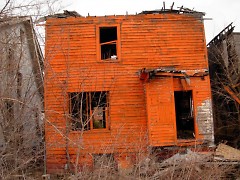
New York City's Hi-Line Park /Courtesy of Ian Irving

One house from Detroit's Project Orange /Courtesy of ExcuseMySarcasm

New York City's Hi-Line Park /Courtesy of Ian Irving

One house from Detroit's Project Orange /Courtesy of ExcuseMySarcasm
Tuesday night two giants of architecuture, art and design- Eva Franch I Gilabert and Reed Kroloff- delivered a talk at the ArtPrize HUB. The purpose is to start Grand Rapids residents to consider the role public spaces play in the lives of citizens and what our public spaces say about us as a society. The first example up for discussion was New York's Hi-Line Park.
"It is a clear example that everyone in that city has agency-public agency," said Kroloff, "and the citzenry who could actually think of a better use, something different, that could happen in that space." Hi-Line Park was established in 1999, and was once part of the historic elevated freight rail that traveled above Manhattan. Kroloff says the space was slated for demolition and redevelopment until two citizens came together to form the park, which has become the second most popular park in New York City.
"I know there are a lot of churches in Grand Rapids," said Franch, "I would say the Hi-Line offers similar space as the church. It is space for contemplation of who we are."
The discussion turned towards public space as a venue for citizen activism, as Franch and Kroloff covered Zucotti Park, the site of Occupy Wallstreet.
"What's fascinating about that moment in the history of the city,"said Franch, "was to see how citizen's managed to take a place, and turn it into a public arena for the discussion, for the construction of an understanding of who we are and what we want."
Kroloff pointed to another example of citizens utilizing public space as a form of social good in Detroit.
"A bunch of anonymous artists from Cranbrook went into old neighborhoods and worked with the local population who wanted houses torn down by the city because they were drug dens, and the city wouldn't do it," said Kroloff "They went out and they bought 50 gallons worth of orange paint and painted the houses bright orange. Then everybody came out, and the city tore them down. These became acts of public engagement."
Franch pointed to ArtPrize as another kind of use of art as social awakening for Grand Rapids.
"What is fascinating is what ArtPrize has been able to construct for Grand Rapids, " said Franch "is something I think might be able to start an understanding of the city and its public space in a much more meaningful and intense manner."
Kroloff ended the talk with two thoughts for Grand Rapids citizens.
"The first question I would ask you," said Kroloff, "while you are wandering through ArtPrize: ask yourself while you're in these spaces, while you're walking those bridges and while you're in those public squares - are these good public spaces? The second question I would ask you to ask is, what are you gonna do about it?"
The Rapidian, a program of the 501(c)3 nonprofit Community Media Center, relies on the community’s support to help cover the cost of training reporters and publishing content.
We need your help.
If each of our readers and content creators who values this community platform help support its creation and maintenance, The Rapidian can continue to educate and facilitate a conversation around issues for years to come.
Please support The Rapidian and make a contribution today.